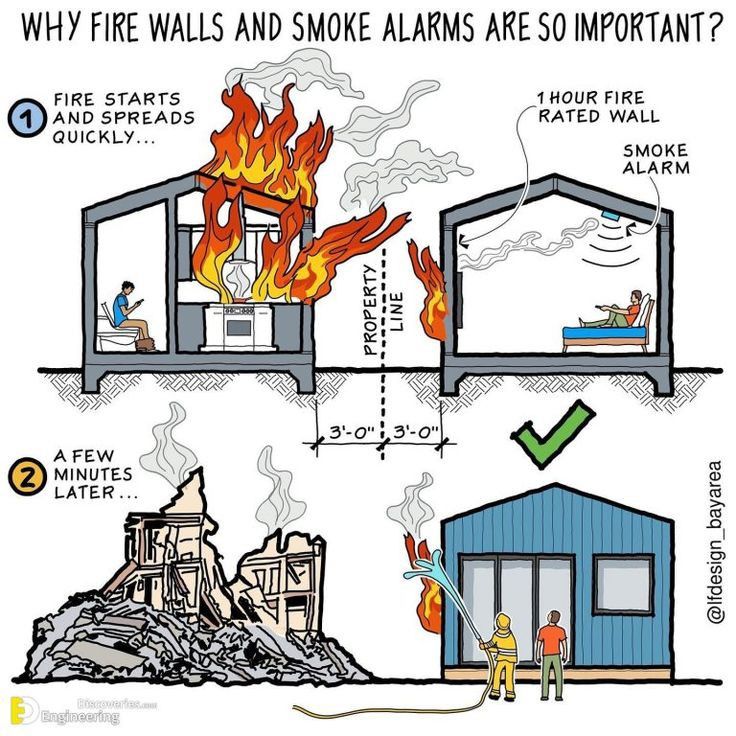How simple design choices and early-warning systems prevent tragedies in residential fires.
🚨 The Hidden Danger in Our Homes
Every year, thousands of lives are lost due to residential fires. While flames may take only seconds to ignite, they can engulf an entire home in minutes. The tragedy is that many of these losses are preventable with the right precautions: fire-rated walls and smoke alarms.
The illustration above provides a clear and sobering example: one home destroyed within minutes, while another remains standing, thanks to simple fire-safety measures.
🔥 How Fires Spread So Quickly
Fire has three deadly qualities:
- Speed – Flames can double in size every 30 seconds.
- Heat – Temperatures in a burning room can exceed 1,000°F (538°C), enough to melt steel.
- Smoke – Toxic fumes kill faster than flames, suffocating occupants before they can escape.
In homes where rooms are built close together and materials are flammable, the chain reaction of destruction can be almost instant.
🏠 The Role of Firewalls
A firewall is not just a barrier; it’s a lifesaving design feature.
- Definition: A fire-rated wall is built with materials (like concrete blocks, fire-rated gypsum, or brick) that can withstand fire for a specified duration, often 1 hour or more.
- Purpose: It contains the fire within one unit or property, giving occupants time to escape and firefighters time to respond.
In the diagram:
- The left house had no firewall → flames spread rapidly and destroyed everything.
- The right house had a 1-hour rated wall → the fire was contained, saving the neighboring home.
This shows that firewalls don’t just protect property — they protect entire communities.
⏰ Smoke Alarms: The Early Warning Heroes
Firewalls help contain the fire, but early detection is equally critical.
- Smoke alarms sense smoke particles before flames become visible.
- They provide life-saving seconds for families to evacuate.
- According to the U.S. Fire Administration, working smoke alarms reduce fire death risk by 55%.
In the diagram, the family sleeping peacefully is safe because a smoke alarm alerted them early, preventing them from being trapped in their beds.
⚠️ A Tale of Two Outcomes
The two halves of the image tell a chilling but hopeful story:
- Without Protection
- Fire starts in a kitchen.
- Flames spread rapidly to the entire home.
- Within minutes, the house collapses to ashes.
- Property and lives are lost.
- With Protection
- Fire starts in a similar setting.
- A firewall slows the flames, protecting neighboring structures.
- A smoke alarm alerts residents, who evacuate safely.
- Firefighters arrive in time to save most of the property.
This difference is not luck — it is planning and design.
🧯 Lessons for Homeowners and Builders
For Homeowners:
- Install smoke alarms in every bedroom, hallway, and living space.
- Test alarms monthly and replace batteries twice a year.
- Create and practice evacuation plans with your family.
For Builders and Architects:
- Always include fire-rated walls in multi-family housing, townhouses, and properties close to each other.
- Use non-combustible materials where possible.
- Ensure that building codes requiring firewall separation are strictly followed.
🌍 Global Fire Safety Context
Different countries enforce fire safety differently:
- United States & Europe – Building codes strictly enforce 1–2 hour rated firewalls in attached homes.
- Developing Nations – Many informal settlements lack proper materials, making them highly vulnerable to catastrophic fires.
- Asia & Middle East – High-rise apartments must integrate smoke alarms, sprinklers, and compartmentalized fire zones.
This makes education and enforcement global priorities.
🧠 The Psychology of Preparedness
Many people believe “it won’t happen to me.” Yet fire statistics show otherwise:
- Most house fires start in kitchens.
- Smoking materials, candles, and faulty wiring are other leading causes.
- Fires often occur at night, when families are least prepared.
That’s why passive safety (firewalls) and active safety (alarms) are non-negotiable. They protect even when people are asleep, distracted, or absent.
🚒 Firefighters’ Perspective
Firefighters emphasize two truths:
- Every second counts. Without firewalls, they often arrive to find the entire structure engulfed.
- Smoke alarms save lives. Firefighters are more likely to rescue survivors from homes with alarms because residents had time to escape.
Thus, these tools not only protect homeowners but also make the job safer for emergency responders.
🏗️ Future of Fire-Safe Design
Architects and engineers are innovating with:
- Smart smoke alarms connected to smartphones.
- Fire-resistant composites that withstand extreme heat.
- Automatic sprinklers paired with alarm systems.
But the fundamental lessons remain timeless: strong firewalls and early detection are the backbone of safety.
📢 Conclusion
The diagram drives home a powerful truth: fire doesn’t have to be a total disaster.
- A home without protection is a ticking time bomb.
- A home with fire-rated walls and working smoke alarms is a safe haven.
As cities grow denser and houses sit closer together, these measures are not luxuries — they are life-saving necessities.
🔥 In short: firewalls protect property, smoke alarms protect people, and together, they save communities.
